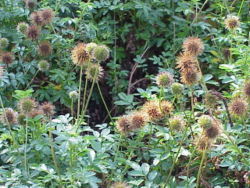| Acaena {{{status}}} Fossil range: {{{fossil_range}}}
|

Acaena novae-zelandiae foliage and various fruiting stages
|
| Plant Info
|
| Common name(s):
|
|
{{{common_names}}}
|
| Growth habit:
|
|
{{{growth_habit}}}
|
| Height:
|
⇕
|
{{{high}}}
|
| Width:
|
⇔
|
{{{wide}}}
|
| Lifespan:
|
⌛
|
{{{lifespan}}}
|
| Exposure:
|
☼
|
{{{exposure}}}
|
| Water:
|
☂
|
{{{water}}}
|
| Features:
|
❀
|
{{{features}}}
|
| Poisonous:
|
☠
|
{{{poisonous}}}
|
| Hardiness:
|
❆
|
{{{hardiness}}}
|
| USDA Zones:
|
|
{{{usda_zones}}}
|
| Sunset Zones:
|
|
{{{sunset_zones}}}
|
|
| Scientific classification
|
| Domain:
|
{{{domain}}}
|
| Superkingdom:
|
{{{superregnum}}}
|
| Kingdom:
|
Plantae
|
| Subkingdom:
|
{{{subregnum}}}
|
| Superdivision:
|
{{{superdivisio}}}
|
| Superphylum:
|
{{{superphylum}}}
|
| Division:
|
Magnoliophyta
|
| Phylum:
|
{{{phylum}}}
|
| Subdivision:
|
{{{subdivisio}}}
|
| Subphylum:
|
{{{subphylum}}}
|
| Infraphylum:
|
{{{infraphylum}}}
|
| Microphylum:
|
{{{microphylum}}}
|
| Nanophylum:
|
{{{nanophylum}}}
|
| Superclass:
|
{{{superclassis}}}
|
| Class:
|
Magnoliopsida
|
| Sublass:
|
{{{subclassis}}}
|
| Infraclass:
|
{{{infraclassis}}}
|
| Superorder:
|
{{{superordo}}}
|
| Order:
|
Rosales
|
| Suborder:
|
{{{subordo}}}
|
| Infraorder:
|
{{{infraordo}}}
|
| Superfamily:
|
{{{superfamilia}}}
|
| Family:
|
Rosaceae
|
| Subfamily:
|
Rosoideae
|
| Supertribe:
|
{{{supertribus}}}
|
| Tribe:
|
Sanguisorbeae
|
| Subtribe:
|
Sanguisorbinae
|
| Genus:
|
Acaena
L.
|
| Subgenus:
|
{{{subgenus}}}
|
| Section:
|
{{{sectio}}}
|
| Series:
|
{{{series}}}
|
| Species:
|
{{{species}}}
|
| Subspecies:
|
{{{subspecies}}}
|
|
| [[{{{diversity_link}}}|Diversity]]
|
| {{{diversity}}}
|
| Binomial name
|
{{{binomial}}}
|
| Trinomial name
|
{{{trinomial}}}
|
| Type Species
|
{{{type_species}}}
|
| Species
|
| See text.
|
[[Image:{{{range_map}}}|{{{range_map_width}}}|]]
|
| Synonyms
|
| {{{synonyms}}}
|
Acaena is a genus of about 100 species of perennial herbs and subshrubs in the Rosaceae, native mainly to the Southern Hemisphere, notably New Zealand, Australia and South America, but with a few species extending into the Northern Hemisphere, north to Hawaii (A. exigua) and California (A. pinnatifida).
The leaves are alternate, 4-15 cm long, and pinnate or nearly so, with 7-21 leaflets. The flowers are produced in a tight globose inflorescence 1-2 cm diameter, with no petals. The fruit is also a dense ball of many seeds; in many (but not all) species the seeds bear a barbed arrowhead point, the seedhead forming a burr which attaches itself to animal fur or feathers for dispersal.
- Selected species
- Acaena adscendens
- Acaena anserinifolia
- Acaena argentea
- Acaena buchananii
- Acaena caesiiglauca
- Acaena exigua - Liliwai
- Acaena fissistipula
- Acaena glabra
- Acaena inermis
- Acaena laevigata
- Acaena lucida
- Acaena magellanica
- Acaena microphylla
|
- Acaena myriophylla
- Acaena novae-zelandiae - bidibid
- Acaena ovalifolia
- Acaena ovina
- Acaena pallida - Sand bidibid
- Acaena pinnatifida - Sheepburr
- Acaena platyacantha
- Acaena pumila
- Acaena saccaticupula
- Acaena sanguisorbae
- Acaena sericea
- Acaena splendens
- Acaena trifida
|
Invasive species
Some species have been introduced accidentally to other areas, attached to sheep's wool, and have become invasive species. A. novae-zelandiae, the bidibid from New Zealand, is the most commonly encountered species in Great Britain, where it is often abundant on coastal sand dunes, crowding out native vegetation and creating an often painful nuisance with the barbed burrs. In California, A. pallida, from New Zealand and southeast Australia, is similarly a problem species.
